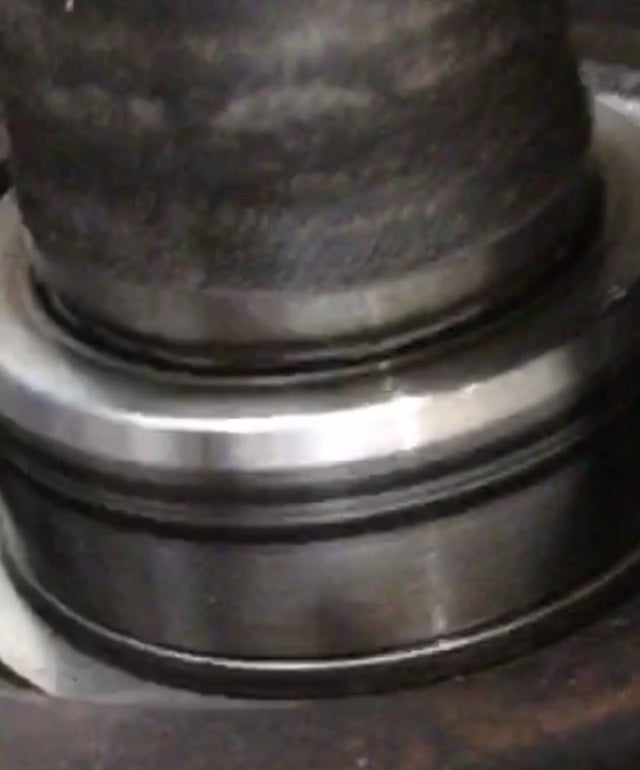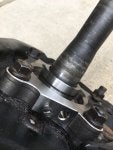I bought a 2007 FJ with 205,000 miles with an obvious rear axle seal leak x2. Got the price down to where I felt it was fair. So the project begins. Let me first say dont use your harbor freight press for this job. Its not up to the task. I destroyed my 12 ton press and never budged the old bearing.
the procedure:
How To FJ cruiser Wheel Bearing Replacment | Overland Adventures and Off-Road
I sourced two new Koyo wheel bearings from Ebay close to $100 each. Bought the tool to press off the bearing for $300. And went to the machine shop of a neighbor to use his 50 ton press. It took about 14 tons of force according to the press gauge to break the old bearing free. (Just sold the tool for $250)
What I determined from a closer inspection of the factory seal setup was something it took me 4 tries to fix on my 99 4Runner. The axle seal is almost designed to leak and I can explain why. The seal is recessed into the axle housing, and the the seal lip is recessed within the seal itself. Toyota designed the retainer with a bevel to "Ease" installation. IMO its not needed. The retainer will easily insert into the the seal if properly and generously greased up. So when you install the retainer with the bevel first, the seal is left with only 2mm of polished mating surface. After some miles and normal wear, the play in the bearing allows the seal to wander over by the bevel and allowing gear oil to get by the seal and migrate through the bearing. Once this happens the grease washes out the lithium bearing grease and permits steel on steel contact in the bearing which over time magnifies the play and excellerates the bearing failure. By simply changing the seal, you will effectively be left without any lubrication once the rest of the gear oil drains out from the bearing. There is the common misconception that the bearings are "sealed". They are considered sealed from dust with a metal cover. But it is not sealed from liquids. The only barrier from gear oil is the axle housing seal. Once that is breached, the oil will penetrate the bearing causing failure typically within 10,000 miles from my experience.
My solution is simple. Reverse the retainer so the bevel faces the wheel. The retainer is 20mm wide and the seal will sit 5mm in from the edge of the retainer giving you enough real estate to stay sealed for life. The reason I mention the retainer width is because you can re-use the old retainer. The old wear marks will be 5-7mm on the bevel side. The other side will have about 12mm of clear virgin seal surface for the new seal. In this picture you can see just how close the seals lip is to the bevel by the witness marks. The bevel measures 3mm and the seal is just 2mm outboard of that bevel.
![Image]()
the procedure:
How To FJ cruiser Wheel Bearing Replacment | Overland Adventures and Off-Road
I sourced two new Koyo wheel bearings from Ebay close to $100 each. Bought the tool to press off the bearing for $300. And went to the machine shop of a neighbor to use his 50 ton press. It took about 14 tons of force according to the press gauge to break the old bearing free. (Just sold the tool for $250)
What I determined from a closer inspection of the factory seal setup was something it took me 4 tries to fix on my 99 4Runner. The axle seal is almost designed to leak and I can explain why. The seal is recessed into the axle housing, and the the seal lip is recessed within the seal itself. Toyota designed the retainer with a bevel to "Ease" installation. IMO its not needed. The retainer will easily insert into the the seal if properly and generously greased up. So when you install the retainer with the bevel first, the seal is left with only 2mm of polished mating surface. After some miles and normal wear, the play in the bearing allows the seal to wander over by the bevel and allowing gear oil to get by the seal and migrate through the bearing. Once this happens the grease washes out the lithium bearing grease and permits steel on steel contact in the bearing which over time magnifies the play and excellerates the bearing failure. By simply changing the seal, you will effectively be left without any lubrication once the rest of the gear oil drains out from the bearing. There is the common misconception that the bearings are "sealed". They are considered sealed from dust with a metal cover. But it is not sealed from liquids. The only barrier from gear oil is the axle housing seal. Once that is breached, the oil will penetrate the bearing causing failure typically within 10,000 miles from my experience.
My solution is simple. Reverse the retainer so the bevel faces the wheel. The retainer is 20mm wide and the seal will sit 5mm in from the edge of the retainer giving you enough real estate to stay sealed for life. The reason I mention the retainer width is because you can re-use the old retainer. The old wear marks will be 5-7mm on the bevel side. The other side will have about 12mm of clear virgin seal surface for the new seal. In this picture you can see just how close the seals lip is to the bevel by the witness marks. The bevel measures 3mm and the seal is just 2mm outboard of that bevel.






















